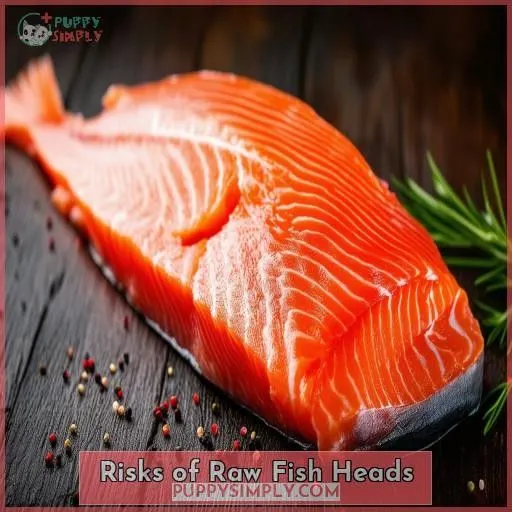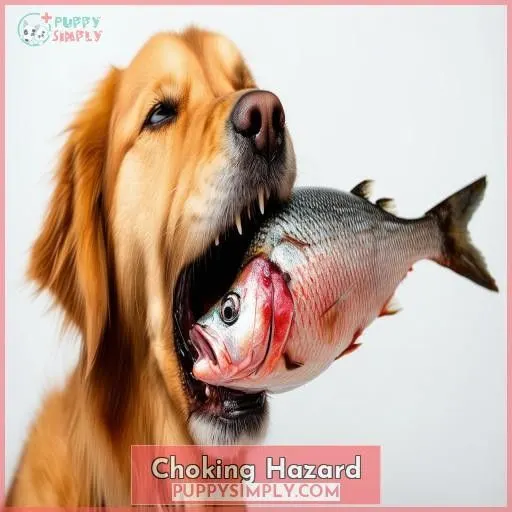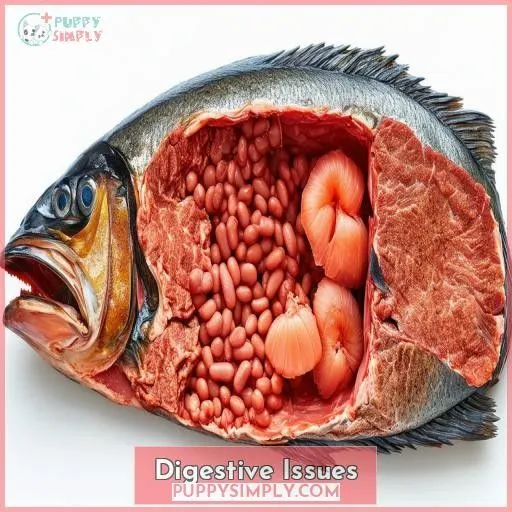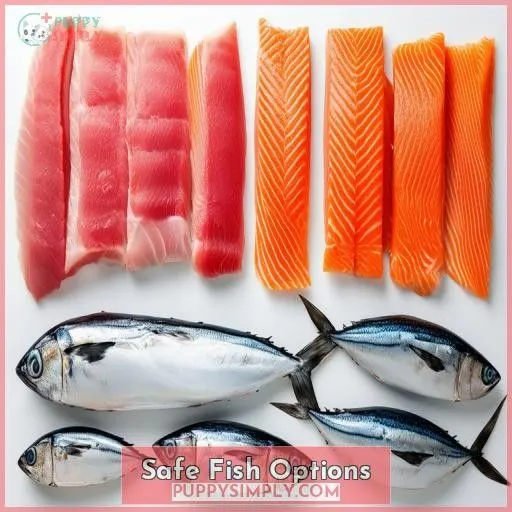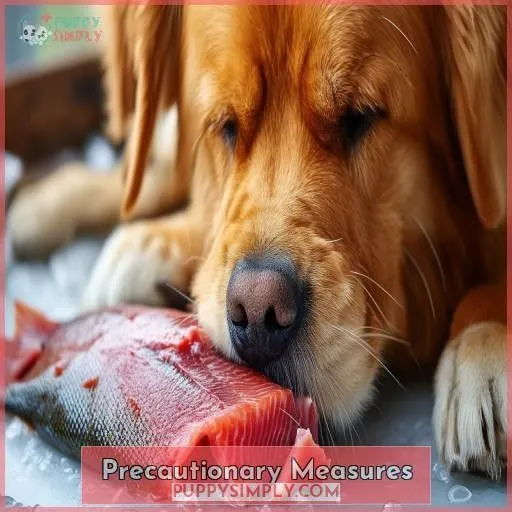This site is supported by our readers. We may earn a commission, at no cost to you, if you purchase through links.
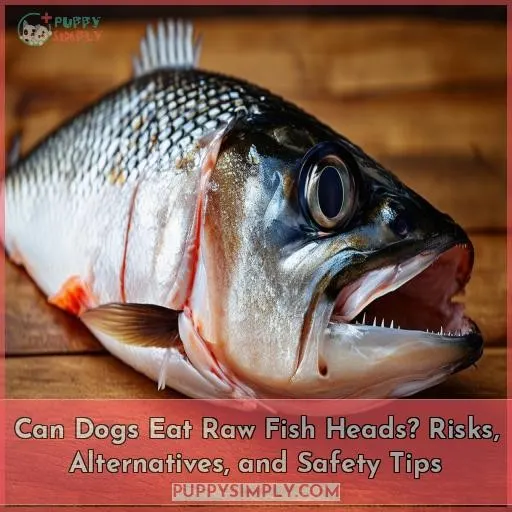 Feeding raw fish heads to dogs isn’t the best idea due to multiple risks. They can harbor parasites, cause bacterial infections, and contain thiaminase, which destroys vitamin B1.
Feeding raw fish heads to dogs isn’t the best idea due to multiple risks. They can harbor parasites, cause bacterial infections, and contain thiaminase, which destroys vitamin B1.
Small, jagged bones pose a Choking hazard and can damage your dog’s digestive tract, potentially causing blockages or perforations.
Instead, opt for boneless cooked fish fillets, which are safer and more digestible.
Always monitor your dog’s diet, seek veterinary advice on introducing new foods, and prioritize their safety. Want to dive deeper into how to keep your pup healthy while enjoying fish? There’s more valuable info ahead!
Table Of Contents
Key Takeaways
- Steer clear of raw fish heads! They’re a breeding ground for parasites and bacteria, just waiting to give your pup a tummy ache.
- Choking hazard alert! Those small, jagged fish bones are like tiny ninjas, ready to lodge themselves in your dog’s throat.
- If you’re thinking about giving your dog a fish head, make sure it’s cooked and boneless. That way, they can enjoy the fishy goodness without the risks.
- Always keep an eye on your dog when they’re eating fish, just to make sure they don’t get into any trouble.
Can Dogs Eat Raw Fish Heads?
No, dogs shouldn’t eat raw fish heads. They pose choking risks and potential digestive problems, like blockages and perforations.
Risks of Raw Fish Heads
You may have heard that feeding raw fish heads to your dog is a tasty treat, but it’s imperative to understand the risks involved.
Raw fish can harbor parasites, bacteria, and heavy metals that could trigger allergic reactions or infections in your furry friend.
Additionally, the presence of thiaminase, an enzyme that destroys thiamine (vitamin B1), can lead to deficiencies.
While occasionally sharing cooked fish is generally safe, regularly feeding raw fish heads puts your pup at risk of digestive issues, nutritional imbalances, and potential health complications.
It’s best to err on the side of caution and explore safer, balanced options for your canine companion’s diet.
Choking Hazard
Consuming raw fish heads poses a significant choking hazard for dogs. The bones can easily lodge in your pet’s throat or airways, potentially leading to life-threatening obstructions that require immediate medical attention.
Bone Lodging in Throat
Raw fish heads pose a significant choking hazard for dogs due to their small, jagged bones. These bones can easily lodge in their throats, potentially causing dental damage, gum disease, inflammation, tooth decay, and soft tissue damage. Avoid feeding raw fish heads to minimize the risk of painful injuries and costly vet visits.
Airway Obstruction
If a fishbone becomes lodged in your dog’s throat, it can lead to a life-threatening airway obstruction. Watch for:
- Excessive drooling or pawing at the mouth
- Labored breathing or wheezing sounds
- Coughing or retching episodes
- Distress and agitation
- Inability to swallow
Immediate veterinary attention is essential to dislodge the obstruction safely and prevent further complications.
Digestive Issues
Besides presenting a choking hazard, raw fish heads can also lead to digestive issues in dogs. Their bones and other components may cause intestinal blockages, perforations, or difficulty digesting, necessitating prompt veterinary attention if problems arise.
Intestinal Blockages
Raw fish heads can lead to intestinal blockages in dogs due to their sharp bones. Bones may splinter and obstruct the digestive tract, causing discomfort and potential perforations. Bacterial contamination from uncooked fish also increases the risk of intestinal distress. Nutritional deficiencies and tooth damage are other concerns when feeding raw fish heads excessively.
Perforations
Fish bones can puncture your dog’s digestive tract, leading to perforations and internal bleeding. This serious condition requires immediate veterinary attention to avoid life-threatening complications. You’ll notice signs like vomiting, abdominal pain, and bloody stools if a fish bone punctures your pup’s intestines.
Difficulty Digesting Bones
You’ll also want to keep in mind that dogs struggle to digest bones, especially larger fish bones. Their size, shape, and density make them difficult for a dog’s digestive system to break down efficiently, which can lead to discomfort, constipation, or even intestinal blockages over time. It’s best to stick with boneless protein sources for your pup’s regular diet.
Safe Fish Options
While raw fish heads can pose risks to your dog’s health, boneless cooked fish fillets make a safer and more digestible option. Occasional treats of cooked fish alongside a balanced diet can provide your pup with valuable nutrients without compromising their well-being.
Boneless Cooked Fillets
For a safer option, opt for boneless, cooked fish fillets. They provide:
- Easily digestible protein
- Lower mercury levels
- Valuable omega-3 fatty acids
Choose sustainably sourced varieties to benefit both your pup’s health and the environment. With proper preparation, these fillets make a nutritious addition to your dog’s diet.
Occasional Treats
You can occasionally offer your pup small, cooked fish treats for a tasty, nutritious reward. Just make certain they’re properly prepared – deboned, skinned, and cooked thoroughly. While packed with benefits like omega-3s, fish should be given in moderation as part of a balanced diet to avoid digestive issues from overindulgence.
Balanced Diet
A balanced diet rich in essential nutrients is crucial for your pup’s overall health. While fish can offer nutritional value, it shouldn’t be their sole protein source. Guarantee variety by alternating species-appropriate proteins, carbs, and vitamins – moderation is essential. Consult your vet for advice on creating a nutrient-balanced diet customized to your furry friend’s needs.
Precautionary Measures
It’s essential to monitor your dog’s consumption of raw fish heads and exercise caution. If you’re uncertain about introducing this food item, it’s best to seek advice from your veterinarian and prioritize your pet’s safety by offering safer alternatives.
Monitoring Consumption
You’ll want to closely monitor your dog’s raw fish head consumption. Set portion limits and stick to infrequent treats. Time feedings carefully, observing for any adverse reactions post-meal. Regulating quantity and frequency is key to preventing potential blockages or digestion issues. Vigilant oversight guarantees your pup stays safe while enjoying the occasional fishy treat.
Seeking Veterinary Advice
While monitoring consumption is essential, you should also consult your veterinarian regarding your dog’s unique dietary needs. They can advise on potential allergies, parasites, and the nutritional value of raw fish heads, considering factors like bone density and infection risks. Seeking professional guidance ensures a balanced, safe approach to incorporating occasional treats.
Prioritizing Pet Safety
Prioritize pet safety by considering ethical considerations and foodborne pathogens. Check the nutritional value of alternative treats, like boneless cooked fillets, ensuring your dog’s health. Monitor consumption, observing for signs of discomfort or illness. Always seek veterinary advice before introducing new foods, keeping your pet’s health paramount.
Frequently Asked Questions (FAQs)
How often can dogs eat fish heads?
Your dog can enjoy fish heads, but moderation is key. Give them fish heads once or twice a week to avoid overloading their diet with those nutrients. Always supervise and make certain the fish is fresh and safe.
What nutrients do fish heads provide dogs?
Fish heads deliver omega-3 fatty acids, promoting healthy skin and coat, while also providing protein for muscle maintenance and growth. They offer vitamins like B12, aiding in energy production and nerve health, and essential minerals.
Can small breeds eat raw fish heads?
Small breeds can eat raw fish heads, but you must be cautious. Make certain the fish is fresh, free from parasites, and the bones are soft to prevent choking or injuries. Always supervise and consult your vet first.
How to train dogs to eat fish heads?
Did you know 80% of dogs can learn new behaviors with treats? Start by offering fish heads as a rare treat, slowly introducing them into your dog’s diet, and reinforcing positive behavior with praise (Source).
Are cooked fish heads better for dogs?
Cooked fish heads offer dogs protein and omega-3 fatty acids without the risks of parasites found in raw fish. They can reduce joint pain and inflammation, making them a better option than raw fish heads (Source).
Conclusion
While dogs may enjoy gnawing on fish heads, it’s better to keep them away from raw options. Feeding raw fish heads to dogs introduces risks like parasites, choking hazards, and digestive issues. Instead, offer boneless cooked fillets for a safer, nutritious treat. Always monitor their diet closely and consult your vet before introducing new foods to guarantee your pet’s health and safety.

